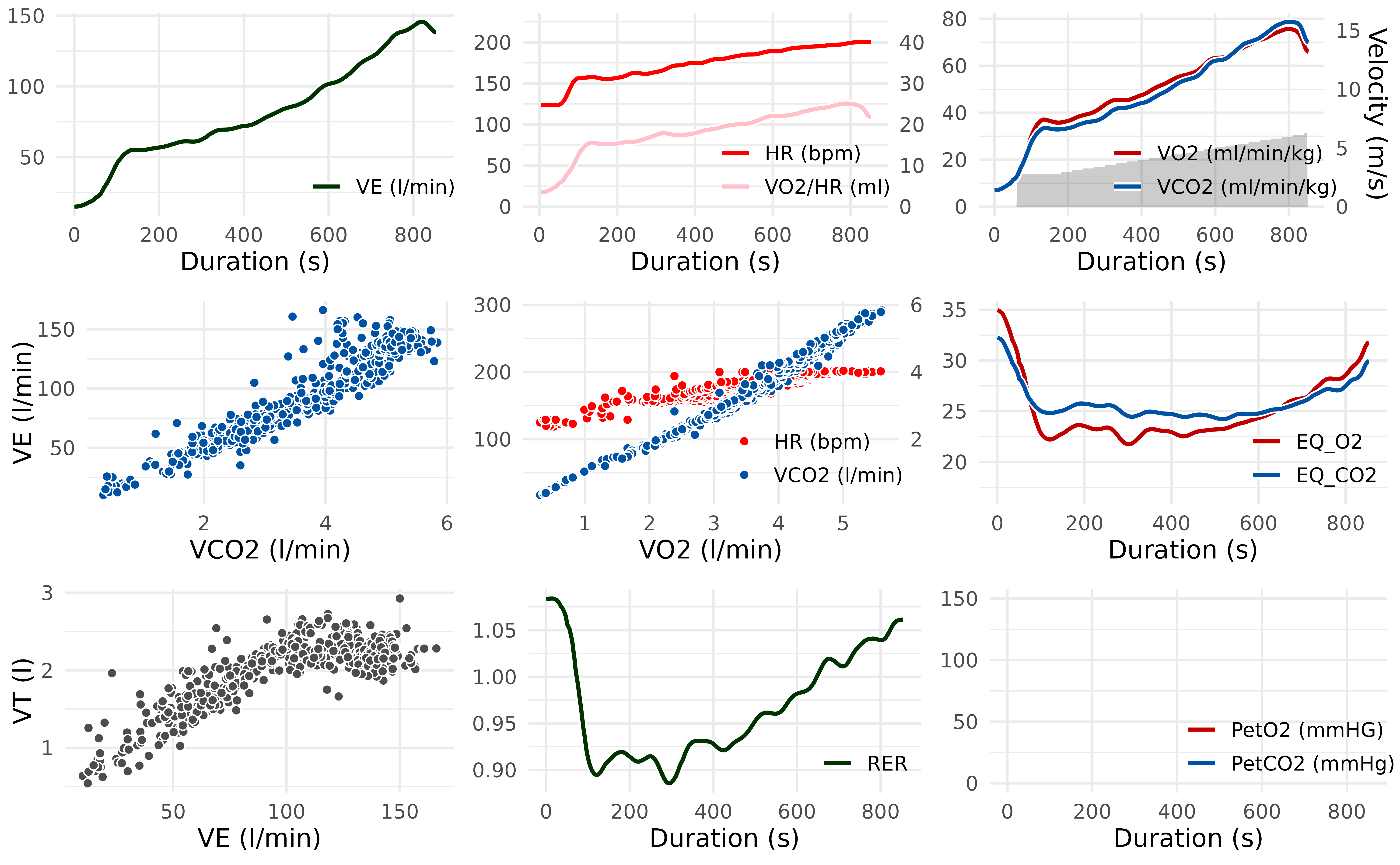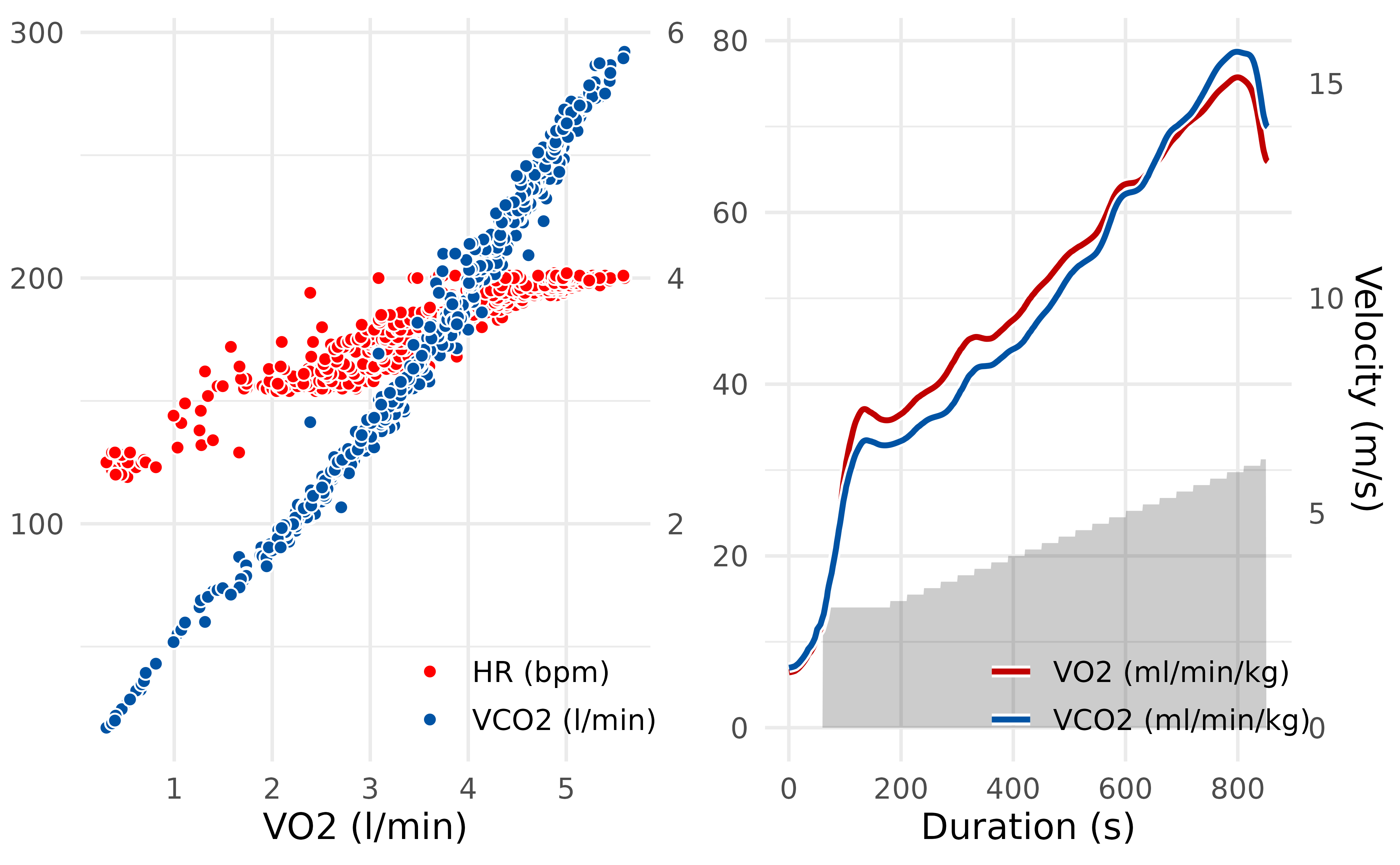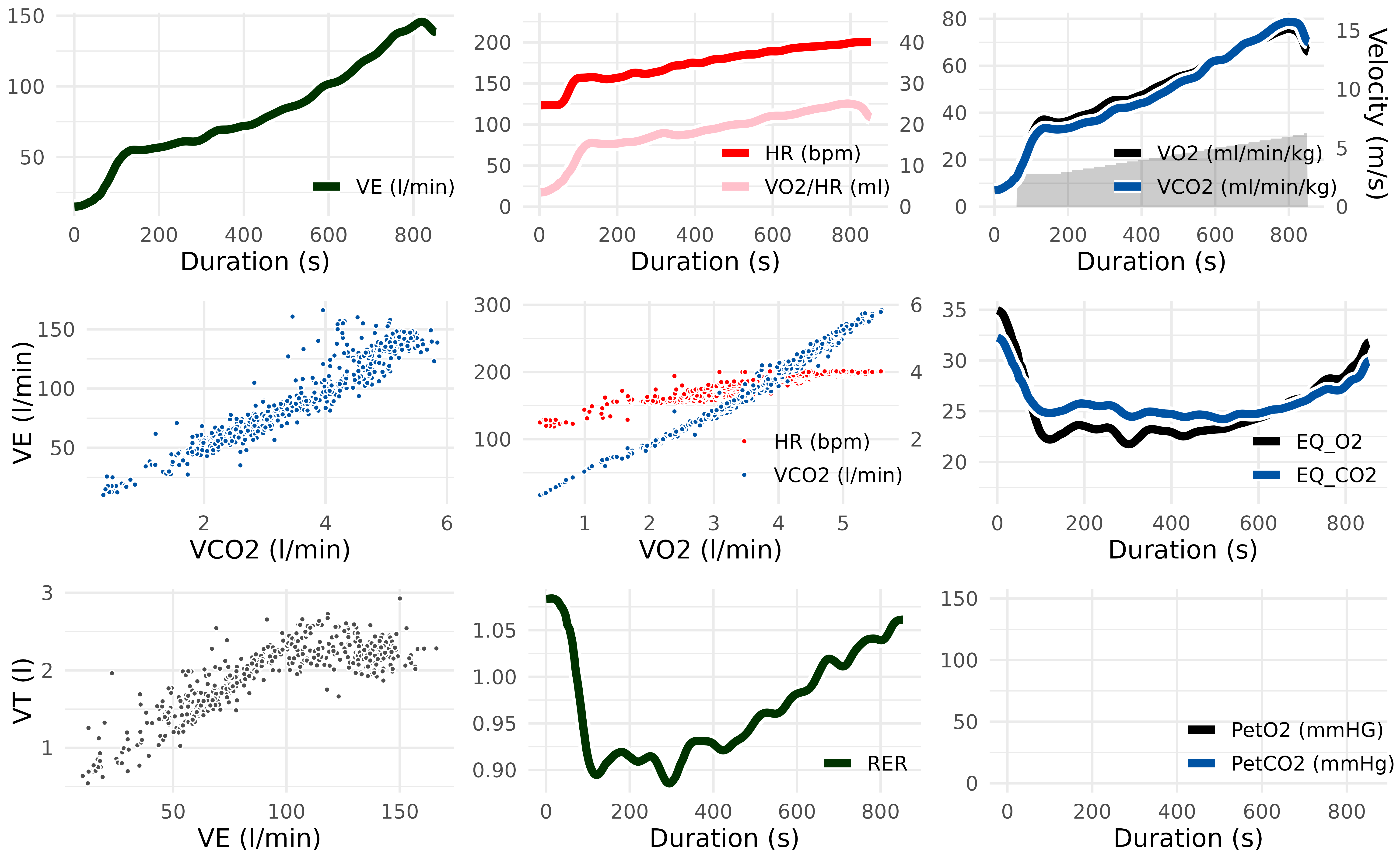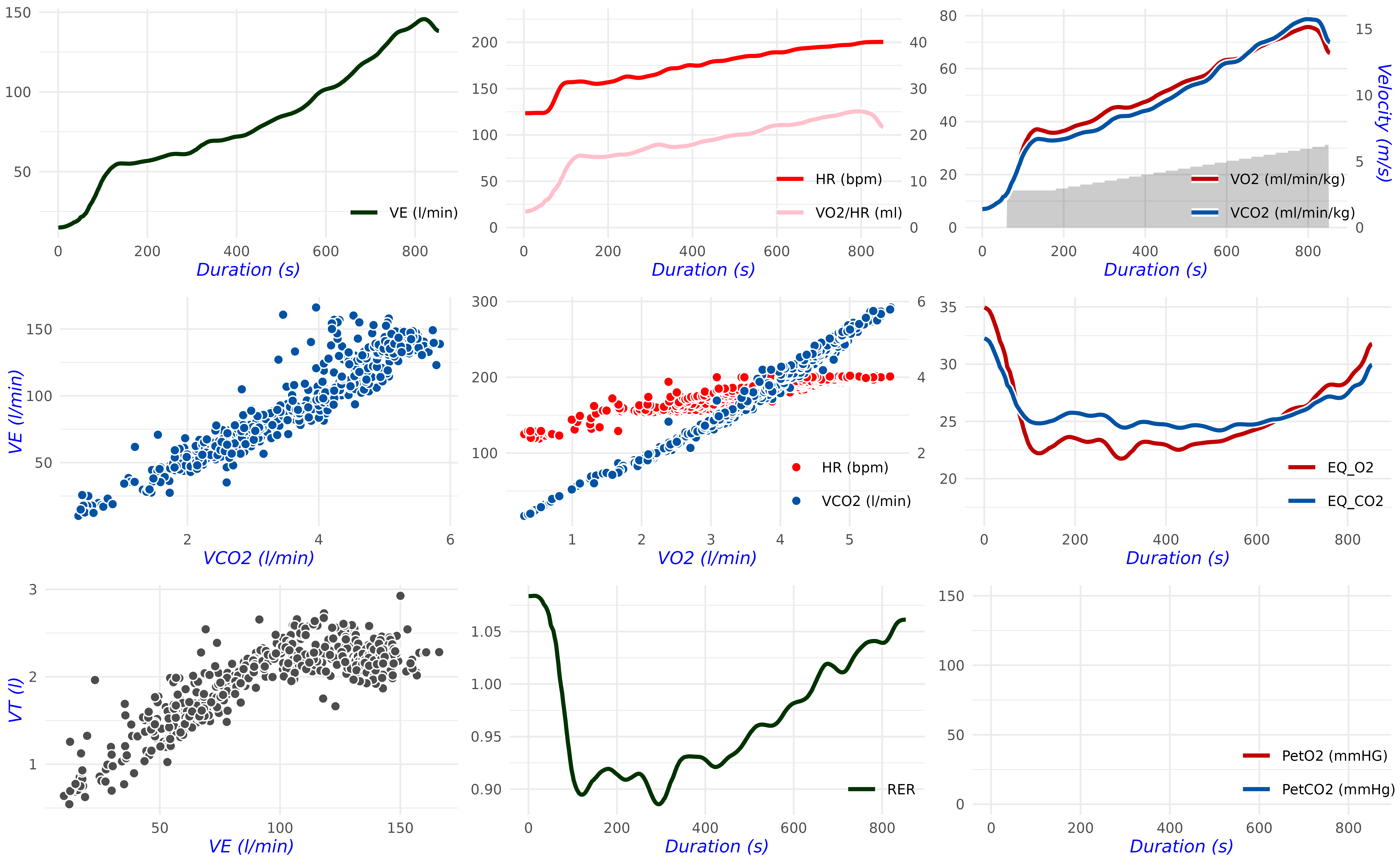Different measuring devices and analysis software lead to opaque
results in measuring gas exchange parameters. To make exercise science
more transparent and reproducible, the spiro package offers
a standardized workflow for data from metabolic carts.
This vignette provides you information on how to summarize and plot
data previously
imported and processed by spiro().
Load the data
library(spiro)
# import and process example data
file <- spiro_example("zan_gxt")
gxt_data <- spiro(file)
gxt_data
#> load step time VO2 VCO2 RR VT VE HR PetO2 PetCO2 VO2_rel
#> 1 0 0 1 NA NA NA NA NA NA NA NA NA
#> 2 0 0 2 NA NA NA NA NA NA NA NA NA
#> 3 0 0 3 NA NA NA NA NA NA NA NA NA
#> 4 0 0 4 399.08 323.70 13.94 0.77 10.72 NA NA NA 6.05
#> 5 0 0 5 409.83 330.26 14.50 0.74 10.66 NA NA NA 6.21
#> 6 0 0 6 420.58 336.82 15.06 0.71 10.60 NA NA NA 6.37
#> 7 0 0 7 431.33 343.37 15.63 0.68 10.53 NA NA NA 6.54
#> 8 0 0 8 435.30 346.51 16.06 0.69 11.04 NA NA NA 6.60
#> 9 0 0 9 437.02 348.52 16.46 0.71 11.74 NA NA NA 6.62
#> 10 0 0 10 438.74 350.53 16.85 0.74 12.44 NA NA NA 6.65
#> VCO2_rel RE RER CHO FO
#> 1 NA NA NA NA NA
#> 2 NA NA NA NA NA
#> 3 NA NA NA NA NA
#> 4 4.90 NA 0.81 0.20 0.13
#> 5 5.00 NA 0.81 0.19 0.13
#> 6 5.10 NA 0.80 0.19 0.14
#> 7 5.20 NA 0.80 0.18 0.15
#> 8 5.25 NA 0.80 0.18 0.15
#> 9 5.28 NA 0.80 0.19 0.15
#> 10 5.31 NA 0.80 0.19 0.15
#> ... with 2999 more rowsStepwise summary with spiro_summary()
In the analysis of gas exchange data, often mean parameters for each performed load step are of interest. To ensure the presence of a metabolic steady state, the end of each step is used for calculations.
spiro_summary(gxt_data, interval = 120)
#> for pre-measures, interval was set to length of measures (60 seconds)
#> step_number duration load VO2 VCO2 VE HR PetO2 PetCO2 VO2_rel
#> 1 0 60 0.0 500.19 411.74 13.03 NA NA NA 7.58
#> 2 1 300 2.0 1860.92 1585.75 39.87 NA NA NA 28.20
#> 3 2 300 2.4 2097.82 1805.27 44.63 NA NA NA 31.79
#> 4 3 300 2.8 2413.01 2122.17 52.63 NA NA NA 36.56
#> 5 4 300 3.2 2710.68 2319.93 57.19 NA NA NA 41.07
#> 6 5 300 3.6 3048.75 2684.87 67.45 NA NA NA 46.19
#> 7 6 300 4.0 3404.02 3026.70 75.91 NA NA NA 51.58
#> 8 7 300 4.4 3724.37 3383.64 88.36 NA NA NA 56.43
#> 9 8 300 4.8 4223.82 3993.55 106.44 NA NA NA 64.00
#> 10 9 300 5.2 4573.91 4488.36 127.54 NA NA NA 69.30
#> RE RER CHO FO
#> 1 NA 0.82 0.27 0.15
#> 2 234.97 0.85 1.27 0.46
#> 3 220.73 0.86 1.51 0.49
#> 4 217.62 0.88 1.95 0.48
#> 5 213.91 0.86 1.89 0.65
#> 6 213.86 0.88 2.47 0.60
#> 7 214.90 0.89 2.90 0.62
#> 8 213.75 0.91 3.50 0.56
#> 9 222.21 0.95 4.68 0.37
#> 10 222.12 0.98 5.82 0.12The length of the computational interval (in seconds) can be modified
with the interval argument. If the interval exceeds the
length of any step, it will be shortened for these steps displaying a
note. You can turn such messages off with setting the argument
quiet = TRUE.
Maximal parameter values with spiro_max()
For some types of exercise tests it may be preferable to get maximal
values of the measured parameters (e.g., the maximum oxygen uptake
VO2max). spiro_max() calculates these after
smoothing the data.
spiro_max(gxt_data, smooth = 30)
#> VO2 VCO2 VE VO2_rel RER HR
#> 1 4732.28 4640.75 129.62 71.7 0.99 NAThe smooth argument controls the interval and method for
the data smoothing. Different smoothing methods are available: Moving
averages over fixed time intervals (e.g. smooth = 30 for 30
seconds), moving averages over a fixed number of breaths
(e.g. smooth = "30b" for 30 breaths) or digital filters
(e.g. smooth = "0.04fz3" for a third-order zero-phase
low-pass Butterworth filter with a cut-off frequency of 0.04 Hz). Per
default the smoothing will not apply to the heart rate values, but you
can enable this behavior with hr_smooth = TRUE.
Plotting the data
The spiro package lets you visualize data from
cardiopulmonary exercise testing: With spiro_plot() you can
display the traditional Wasserman 9-Panel Plot.
# load example data
data <- spiro(spiro_example("zan_ramp"), hr_file = spiro_example("hr_ramp.tcx"))
spiro_plot(data)
You can individually select and combine panels of the 9-Panel Plot by
setting the which argument.
# Plot only V-Slope (Panel 5) and VO2/VCO2 over time (Panel 3)
spiro_plot(data, which = c(5, 3))
Data over time (Panel 1,2,3,6,8,9) will be displayed smoothed, as
determined via the smooth argument. The other panels
(4,5,7) use the raw breath-by-breath data for visualization.
You can control the appearance of the plots in
spiro_plot(). Use the style_args argument to
control the size and color of points and lines.
# Change size of points, width of lines and color of VO2 points/lines
spiro_plot(
data,
style_args = list(
size = 1,
linewidth = 2,
color_VO2 = "black"
)
)
Use the base_size argument to change the plot base size.
You can pass other style arguments to ggplot::theme() via
the style_args argument for further customization.
# Change base size and axis label font
spiro_plot(
data,
base_size = 9,
style_args = list(
axis.title = ggplot2::element_text(face = "italic", colour = "blue")
)
)
